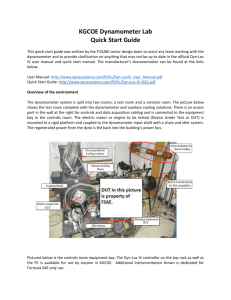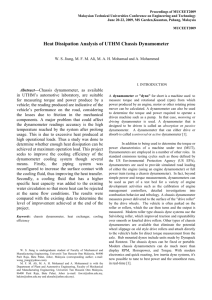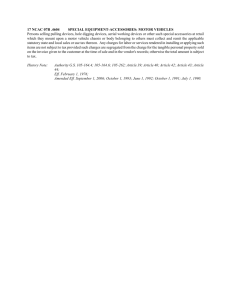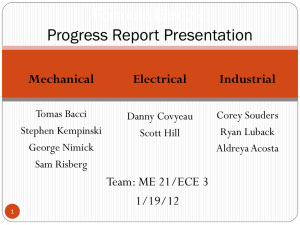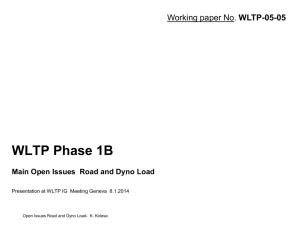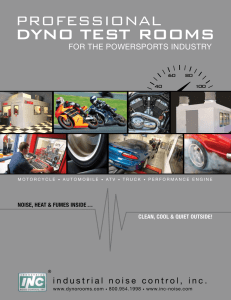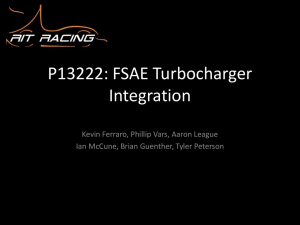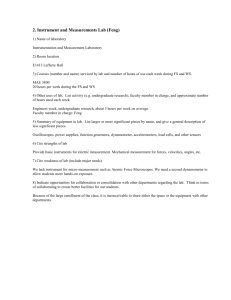Introduction How Dynamometers Work
advertisement
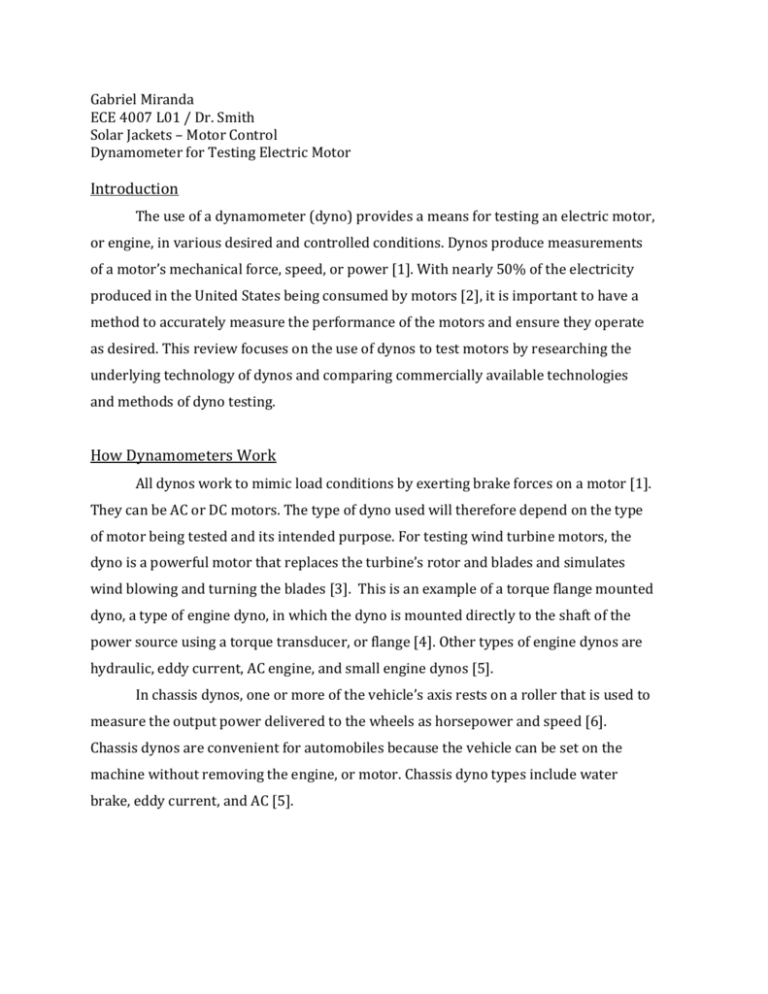
Gabriel Miranda ECE 4007 L01 / Dr. Smith Solar Jackets – Motor Control Dynamometer for Testing Electric Motor Introduction The use of a dynamometer (dyno) provides a means for testing an electric motor, or engine, in various desired and controlled conditions. Dynos produce measurements of a motor’s mechanical force, speed, or power [1]. With nearly 50% of the electricity produced in the United States being consumed by motors [2], it is important to have a method to accurately measure the performance of the motors and ensure they operate as desired. This review focuses on the use of dynos to test motors by researching the underlying technology of dynos and comparing commercially available technologies and methods of dyno testing. How Dynamometers Work All dynos work to mimic load conditions by exerting brake forces on a motor [1]. They can be AC or DC motors. The type of dyno used will therefore depend on the type of motor being tested and its intended purpose. For testing wind turbine motors, the dyno is a powerful motor that replaces the turbine’s rotor and blades and simulates wind blowing and turning the blades [3]. This is an example of a torque flange mounted dyno, a type of engine dyno, in which the dyno is mounted directly to the shaft of the power source using a torque transducer, or flange [4]. Other types of engine dynos are hydraulic, eddy current, AC engine, and small engine dynos [5]. In chassis dynos, one or more of the vehicle’s axis rests on a roller that is used to measure the output power delivered to the wheels as horsepower and speed [6]. Chassis dynos are convenient for automobiles because the vehicle can be set on the machine without removing the engine, or motor. Chassis dyno types include water brake, eddy current, and AC [5]. Using a Dynamometer The key component in dyno testing is the dynamometer itself. As was mentioned previously, dynos come in different types but all work to achieve the same goal; create a load and measure motor performance. Special software is also required to properly run dyno testing. This software allows the user to have complete control over the motor or vehicle parameters via computer; these controls include speed, torque, and horsepower [5]. Dyno software also allows the user to run drive cycle simulations. Examples of these drive cycles are the Urban Dynamometer Driving Schedule (UDDS) and the Highway Fuel Economy Driving Schedule (HWFEDS), whose results are used by the EPA when labeling a vehicles fuel economy [7]. Commercial Use Dynamometers are used to test motor and engine performance and fine-tune them to maximize power output and/or efficiency. Dyno prices vary, with basic twowheel drive (2WD) models, such as the DYNOmite 2000-Lite 2WD IO Chassis Dyno, starting at $14,950. Eddy current dynos are more expensive with the entry level DYNOmite 850-Lite 2WD EC Chassis Dyno priced at $19,950. Water brake dynos have the highest starting price, $29,950 for DYNOmite’s 1200 2WD WB Chassis Dyno [8]. The top of the line DYNOmite dyno, the 8800-Pro 4WD EC Chassis Dyno, costs $117,000. This is an eddy current dyno and is capable of handling four-wheel drive (4WD) and all-wheel drive (AWD) vehicles. It also comes with a computer, printer and software package, and is capable of handling speeds up to 250mph [8]. Other industry leaders in dyno technology include DynoJet and DynoDynamics; both DynoJet and DynoDynamics offer 2WD and 4WD chassis dynos [9], [10]. DynoJet also offers motorcycle and ATV/Kart dynos [9], while DynoDynamics offers engine dynos that are customized to fit customer needs [10]. References [1] Dyne Systems. (2010). AC Dynamometers for Engine and Motor Testing. [Company Website]. Available: http://www.dynesystems.com/acdynamometers.htm [2] Reliant Energy. (2011). AC Induction Motors. [Company Website]. Available: http://www.reliant.com/en_US/Page/Generic/Public/ esc_purchasing_advisor_ac_induction_motors_bus_gen.jsp#top [3] National Renewable Energy Lab. (2010, Nov 01). Dynamometer Testing (Fact Sheet). [Online]. Available: http://dx.doi.org/10.2172/993331 [4] A.J. Martyr and M.A. Plint, “Dynamometers and the measurement of torque,” in Engine Testing: Theory and Practice, 3rd ed. Oxford: Butterworth-Heinemann, 2007, pp. 153-157. [E-book]. Available: http://www.engineeringvillage.com.www.library.gatech.edu:2048/controller/s ervlet/Controller?CID=quickSearchCitationFormat&RERUN=1bbc77912df81722 15M6bdfprod4data1&database=131072&STEP=1 [5] Taylor Dynamometer. DynPro: The Ultimate in Instrumentation. [Sales Literature]. Available: http://www.taylordyno.com/sites/default/files/ DynPro_Brochure_0.pdf [6] GlobalSpec. Dynamometers Information on GlobalSpec. [Online]. Available: http://www.globalspec.com/LearnMore/Sensors_Transducers_Detectors/Torqu e_Sensing/Dynamometers [7] M. Duoba, R. Carlson, F. Jehlik, J. Smart, and S. White. “Correlating Dynamometer Testing to In-Use Fleet Results of Plug-In Hybrid Electric Vehicles,” in International Electric Vehicle Symposium 24, Stravenger, Norway, 2009, pp. 1-3. [8] DYNOmite. (2011). Automotive Chassis Dynamometer Prices and Models. [Company Website]. Available: http://www.land-and-sea.com/chassisdyno/chassis-dyno-price.htm [9] DynoJet Research. [Company Website]. Available: http://dynojet.com [10] DynoDynamics. [Company Website]. Available: http://www.dyno.com.au/dyno/controller/home

